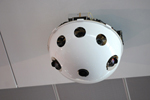
DHS-Designed Camera Employs Image Stitching Technology To Provide 100 Megapixel Resolution
Traditional surveillance cameras can be of great assistance to law enforcement officers for a range of scenarios -- canvassing a crowd for criminal activity, searching for who left a suitcase beneath a bench, or trying to pick out a suspect who has fled a crime scene and blended into a teeming throng in the subway.
But there are shortfalls. For starters, once they zoom in on a specific point of interest, they lose visual contact with the rest of the scene.
Now, a new video surveillance system currently being developed by the Department of Homeland Security’s Science and Technology Directorate (S&T) may soon give law enforcement an extra set of eyes. The Imaging System for Immersive Surveillance (or ISIS) takes new video camera and image-stitching technology and bolts it to a ceiling, mounts it on a roof, or fastens it to a truck-mounted telescoping mast.
Like a bug-eyed fisheye lens, ISIS sees v-e-r-y wide. But that’s where the similarity ends. Whereas a typical fisheye lens distorts the image and can only provide limited resolution, video from ISIS is perfectly detailed, edge-to-edge. That’s because the video is made from a series of individual cameras stitched into a single, live view -- like a high-res video quilt.
“Coverage this sweeping, with detail this fine, requires a very high pixel count,” said program manager Dr. John Fortune, of S&T’s Infrastructure and Geophysical Division, “ISIS has a resolution capability of 100 megapixels.”
That’s as detailed as 50 full-HDTV movies playing at once, with optical detail to spare. You can zoom in close…and closer…without losing clarity.
The stitching together of several images isn’t exactly cutting-edge magic. For years, creative photographers have used low-cost stitching software to create breathtaking high-res images (like that famous image of the National Mall from Inauguration Day 2009). But those are still images, created days or weeks after a scene was shot. ISIS is quilting video -- in real time. And, a unique interface allows maintenance of the full field of view, while a focal point of choice can be magnified.
Other tricks -- many of which are commercially available -- will be provided by a suite of software applications called video analytics. One app can define a sacrosanct “exclusion zone,” for which ISIS provides an alert the moment it’s breached.
Another lets the operator pick a target -- a person, a package, or a pickup truck -- and the detailed viewing window will tag it and follow it, automatically panning and tilting as needed. Video analytics at high resolution across a 360-degree field of view, coupled with the ability to follow objects against a cluttered background, would provide enhanced situational awareness as an incident unfolds.
In the event that a terrorist attack occurs, forensic investigators can pore over the most recent video, using pan, zoom, and tilt controls to reconstruct who did what and when. Because these controls are virtual, different regions of a crime scene can feasibly be studied by separate investigative teams simultaneously.
Many of the ISIS capabilities were adapted from technology previously developed by MIT’s Lincoln Laboratory for military applications. With the help of technology experts from the Department of Energy’s Pacific Northwest National Laboratory, Lincoln Laboratory has built the current system with commercial off-the-shelf cameras, computers, image processing boards and software.
ISIS creators already have their eyes on a new and improved second generation model, complete with custom sensors and video boards, longer range cameras, higher resolution, a more efficient video format, and a discreet, chandelier-like frame -- no bigger than a basketball. Eventually, the Department plans to develop a version of ISIS that will use infrared cameras to detect events that occur at night.
S&T formed a partnership with the Massachusetts Port Authority (Massport), and in December 2009, began an ISIS pilot at Logan International Airport, allowing potential Homeland Security end users the opportunity to evaluate the technology. Beyond the potential for enhancing security at our nation’s airports, if successful, the current testing at Logan could pave the way for the eventual deployment of ISIS to protect other critical venues.
That’s a good thing, says S&T’s Fortune.
“We’ve seen that terrorists are determined to do us harm, and ISIS is a great example of one way we can improve our security by leveraging our strengths,” he said.